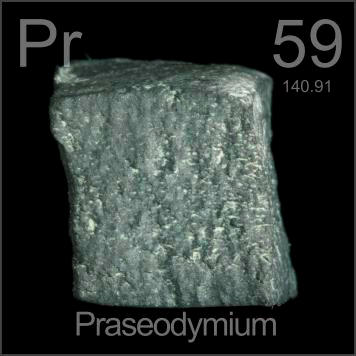Praseodymium is a chemical element with atomic number 59 and chemical symbol Pr. This element is the third member of the lanthanide series and is categorized as a rare-earth metal. It is soft, silvery, malleable, and ductile. The metal is valued for its magnetic, electrical, chemical, and optical properties. Praseodymium is actually too reactive and not available in its native form. Besides, pure praseodymium metal slowly develops a green oxide coating when exposed to air.
Like most of the other rare-earth elements, praseodymium most readily forms the +3 oxidation state, which is its only stable state in an aqueous solution. However, the +4 oxidation state has been identified in some solid compounds, specifically among lanthanides. Even the +5 oxidation state is attainable in matrix-isolation conditions.

Occurrence and Discovery of Rare Earth Praseodymium
Praseodymium is always found naturally together with the other rare-earth metals. It is the sixth-most abundant rare-earth element and fourth-most abundant lanthanide. Praseodymium makes up 9.1 parts per million of the Earth’s crust, an abundance similar to that of boron. In 1841, Swedish chemist Carl Gustav Mosander extracted a rare-earth oxide residue, which he later called didymium from a residue, which is called lanthana.
In 1885, Austrian chemist Carl Auer von Welsbach separated didymium into two elements, yielding salts of different colors, which he named praseodymium and neodymium. The name praseodymium comes from the Ancient Greek πράσινος (prasinos), meaning ‘leek-green’, and δίδυμος (didymos) ‘twin’.
Praseodymium can be found in different minerals, with larger quantities of the element available in monazite and bastnasite. Recent methodologies, such as ion exchange and solvent extraction, have helped to make the isolation of many rare-earth elements very easy. Praseodymium can also be obtained through calcium reduction of the anhydrous chloride of fluoride.
Properties of Rare Earth Praseodymium
- Praseodymium is the third member in the lanthanide series.
- It is categorized as a rare-earth metal.
- It is a ductile metal with a hardness comparable to that of silver.
- Like most metals in the lanthanide series, praseodymium usually only uses three electrons Praseodymium nevertheless can also lose a fourth and sometimes, a fifth valence electron.
- It has two allotropic forms. At about 560 °C, it transitions to a face-centered cubic structure, and a body-centered cubic structure appears shortly before the melting point of 935 °C.
- Just like most other lanthanides, praseodymium is paramagnetic at room temperature. Unlike some other rare-earth metals that are antiferromagnetic or ferromagnetic ordering at low temperatures, praseodymium is paramagnetic at all temperatures above 1 K.
- Praseodymium has only one stable and naturally occurring isotope, 141Pr. It is a mononucleic and monoisotopic element. Aside from this, 38 other radioisotopes have been synthesized, all of which have half-lives of under 24 hours.
- Praseodymium metal tarnishes slowly in the air to form a spalling green oxide layer like iron rust.
- Praseodymium reacts slowly with cold water and rather quickly with hot water to form praseodymium(III) hydroxide.
Modern Applications of Rare Earth Praseodymium
- Combined with neodymium, praseodymium is used for creating high-power magnets that are known for their strength and durability.
- Praseodymium – nickel combination shows a strong magnetocaloric effect indicating that it has allowed scientists to approach within one-thousandth of a degree of absolute zero.
- Praseodymium sputtering targets and praseodymium evaporation materials are used in deposition processes including semiconductor deposition, chemical vapor deposition (CVD) and physical vapor deposition (PVD).
- Praseodymium is applied as an alloying agent alongside magnesium to create high-strength metals that are used in aircraft engines; yttrium and neodymium are also viable substitutes.
- Praseodymium is used in the rare-earth mixture whose fluoride forms the core of carbon arc lights. These are used in the motion picture industry for studio lighting and projector lights.
- Praseodymium compounds are used in making glasses, enamels, and ceramics to come out with a yellow color.
- Praseodymium is a part of didymium glass, which is used to make certain types of welders and glass blower goggles.
- A solution of praseodymium oxide with ceria or ceria-zirconia is useful as an oxidation catalyst.
Conclusions
Praseodymium is a chemical element with atomic number 59 and is considered to be one of the rare-earth metals. The element is a soft, silvery, malleable, and ductile metal, which is used for its magnetic, electrical, chemical, and optical properties. Praseodymium is used in combination with other rare-earth elements to produce useful alloys and mixtures for a variety of applications.




